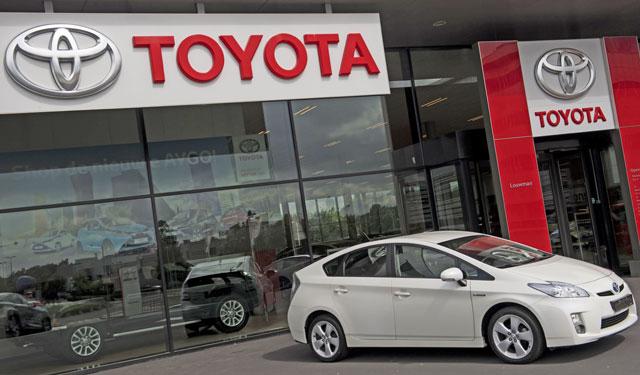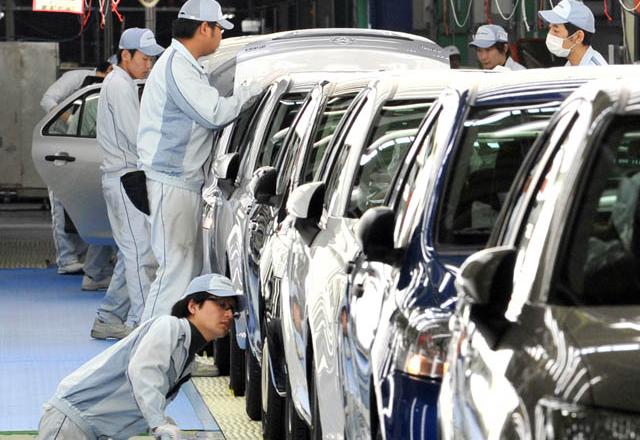You are here
In green car race, Toyota adds muscle with fuel-cell launch
By Reuters - Apr 17,2014 - Last updated at Apr 17,2014

TOKYO –– In 1997, Toyota caught its competitors by surprise with the revolutionary Prius, the first commercially successful gasoline-electric hybrid car. Now, the Japanese firm is trying to do the same with a technology that seems straight out of science fiction.
Toyota Motor Corp. will next year launch a hydrogen-powered car in the US, Japan and Europe. For now, people at Toyota are calling it the 2015 FC car, for fuel-cell.
Fuel-cell cars use a “stack” of cells that electro-chemically combine hydrogen with oxygen to generate electricity that helps propel the car.
Their only emission, bar heat, is water vapour; they can run five times longer than battery electric cars, and it takes just minutes to fill the tank with hydrogen –– far quicker than even the most rapid charger can recharge a battery electric car.
The 2015 launch culminates a 20-year zig-zag quest during which Toyota first struggled to get the technology to work and then strained to lower manufacturing costs enough to permit realistic pricing. It has also been playing catch-up to rival Honda Motor Co., which has set the early pace with its FCX Clarity, a sleek, purpose-built hydrogen car.
The cost-cutting continues, though Toyota thinks it has cracked the code with incremental design improvements, such as using wider, flatter “fettuccine-style” copper in coils that make the motor more powerful, and thus smaller and cheaper.
“With the 2015 FC car we think we’ve achieved a degree of dominance over our rivals,” Satoshi Ogiso, a Toyota managing director, said in a recent interview at the group’s global headquarters. “With the car, we make a first giant step” toward making fuel-cell vehicles practical for everyday use.
What’s more, executives and engineers say Toyota is willing to sell the car at a loss for a long while to popularise the new technology — just as it did with the Prius, which, with other hybrids, now accounts for 14 per cent of Toyota’s annual sales, excluding group companies, of around 9 million vehicles.
As a result, drivers in key “green” markets such as California may be able to buy the car for a little more than $30,000-$40,000, after government subsidies — if management approves a pricing strategy put forward by a group of managers and engineers. General Motors Co.’s Chevrolet Volt, a near-all-electric plug-in hybrid, for comparison, starts at around $35,000 in the US.
The stakes are high — for global automakers, oil producers, economies and the environment.
Infrastructure roadblocks
As with battery electric cars, a major challenge for fuel-cell automakers is a lack of infrastructure, with few hydrogen fuel stations in the world. Estimates vary, but it costs about $2 million to build a single hydrogen fuel station in the US, according to Toyota executives.
Safety is also a concern. Hydrogen is a highly flammable element when not handled properly.
The Toyota launch pits fuel-cell technology against battery electric in a race to capture the hearts and wallets of drivers looking for engines that are easier on the environment. Automakers are under pressure to invest in so-called “zero-emission” cars as tougher rules globally demand lower harmful emissions and better fuel economy.
It’s a polarising debate.
Takeshi Uchiyamada, the 67-year-old “father of the Prius” whose success catapulted him from mid-level engineer to Toyota board chairman, says technology inefficiencies will make the battery electric car little more than an “errands car” — a small run-around for shopping, dropping the kids at school and other short-haul chores.
Other global automakers in the fuel-cell camp include Daimler AG, Hyundai Motor Co. and Honda, which plans to introduce an upgraded FCX Clarity next year with seating for five, a smaller fuel-cell stack, greater power and a longer driving range.
Those betting on battery electric cars include Nissan Motor Co., Tesla Motors Inc., Bayerische Motoren Werke AG, GM, Ford Motor Co. and Chinese automakers backed by the country’s industrial policy makers. China offers generous purchase incentives for those buying battery electric cars and aims to have 5 million “new energy” vehicles — mostly all-electric and near all-electric plug-in hybrids — on the road by 2020. Several of these will be exhibited at the Beijing auto show from April 20.
Even Toyota only expects tens of thousands of fuel-cell cars to be sold each year a decade from now as the new technology will need time to gain traction.
Related Articles
TOYOTA CITY, Japan — Engineers at Toyota Motor Corp.
WASHINGTON/TOKYO — Toyota Motor Corp.
Toyota sold a record 9.98 million vehicles last year, it pointed out Thursday, outpacing rivals General Motors (GM) and Volkswagen to maintain its title of world’s biggest automaker.















